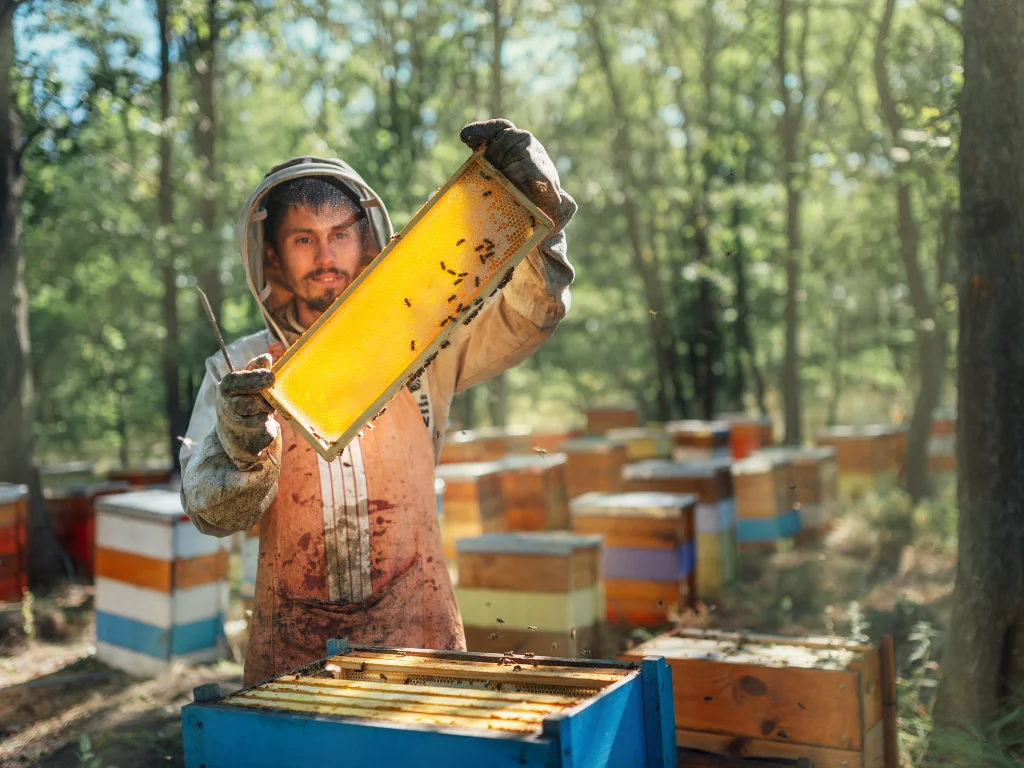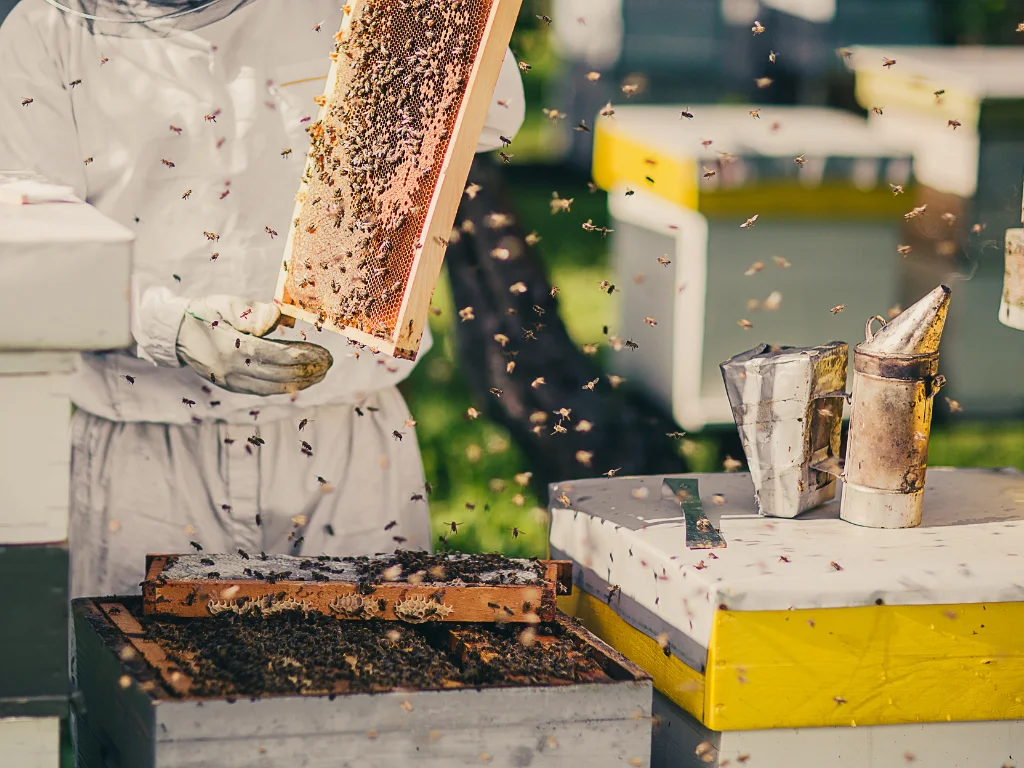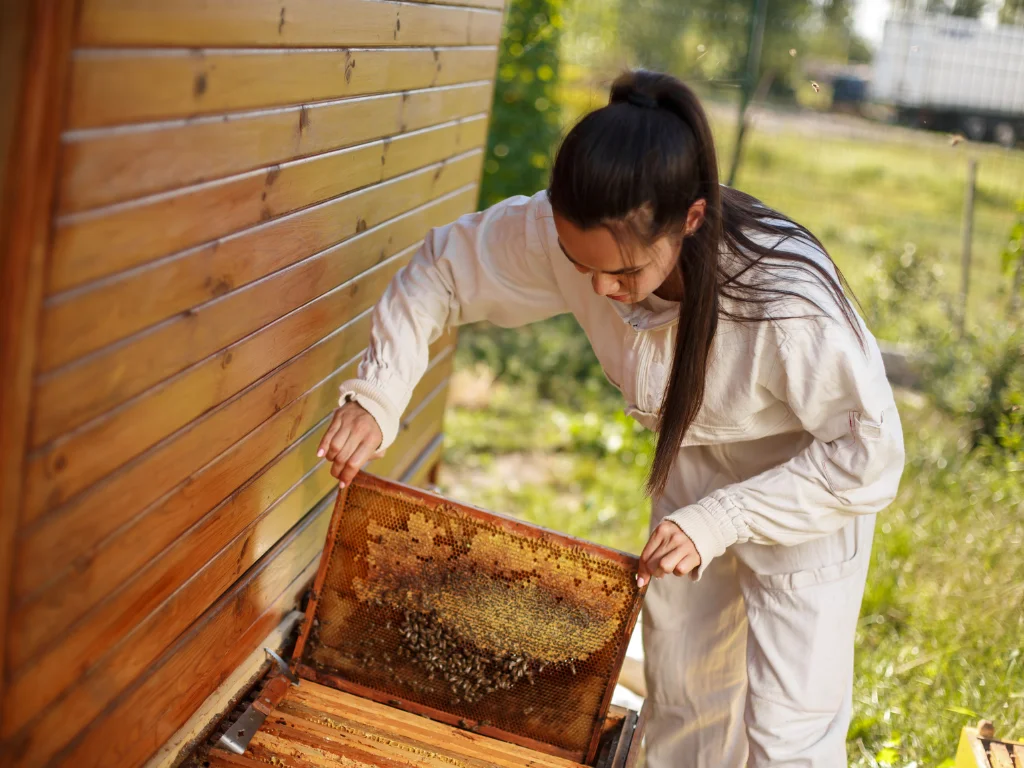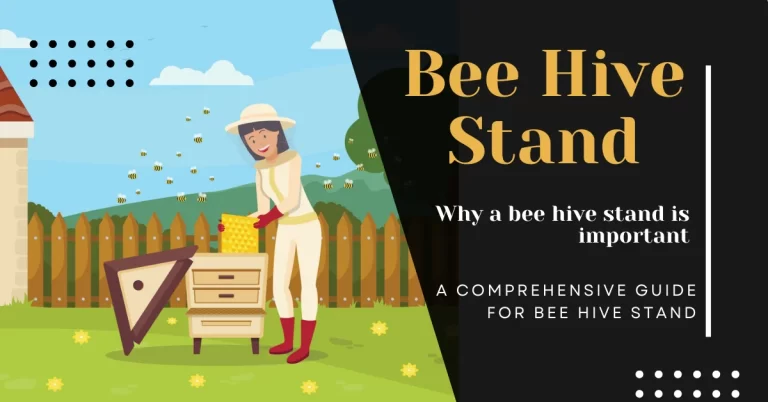What is Beekeeping: A Comprehensive Guide
Beekeeping, also known as apiculture, maintains and manages bee colonies, typically in man-made hives. This activity is an ancient tradition and a modern agricultural practice critical in pollination and honey production.
The Basics of Beekeeping
Beekeeping involves:
- Housing bees in hives: These hives can be wooden boxes or other structures designed to provide a safe environment for the bees.
- Monitoring bee health: Regular inspections help ensure the colony is thriving and disease-free.
- Harvesting honey and other products: Beekeepers collect honey, beeswax, pollen, and propolis from the hives.
- Pollination: Bees naturally pollinate plants as they collect nectar, essential for producing many crops.

Essential Equipment
- Beehives: Structures where bees live and work.
- Protective gear: Suits, gloves, and veils to protect beekeepers from stings.
- Smokers: Devices that produce smoke to calm bees during hive inspections.
- Hive tools: Used for opening hives and handling frames.
Benefits of Beekeeping
- Honey production: Fresh, natural honey is a primary benefit.
- Pollination: Bees contribute to the growth of fruits, vegetables, and flowers.
- Environmental impact: Beekeeping supports biodiversity and helps maintain ecological balance.
- Economic benefits: Selling honey and other bee products can be profitable.
Challenges in Beekeeping
- Diseases and pests: Varroa mites, foulbrood, and other issues can harm bee colonies.
- Weather conditions: Extreme temperatures and weather changes can affect hive health.
- Colony Collapse Disorder (CCD): A phenomenon where worker bees disappear, leading to hive failure.
Getting Started with Beekeeping
- Research and Education: Learn about bee biology, behavior, and beekeeping practices through books, online resources, and local beekeeping associations.
- Obtain Equipment: Purchase or build hives, protective clothing, and necessary tools.
- Acquire Bees: Buy bees from a reputable supplier or catch a swarm.
- Set Up Your Apiary: Choose a suitable location for your hives, considering factors like accessibility, sunlight, and water sources.
- Maintain Your Hives: Regularly check on your bees, manage pests, and ensure they have enough food, especially during winter.
What is beekeeping called?
Beekeeping is commonly referred to as “apiculture.” The term “apiculture” originates from the Latin word “apis,” meaning “bee.” It encompasses the art and science of raising and managing honeybees for various purposes, including honey production, pollination services, and the overall well-being of bee colonies.
Apiculture involves providing a suitable environment for bees within artificial hives, ensuring their health, and undertaking necessary tasks to support their survival and productivity.
Beekeepers, also known as apiarists, play a vital role in the preservation and sustainable utilization of honeybee populations.
Types of beekeeping
- Hobby Beekeeping:
- This is beekeeping practiced as a hobby or leisure activity. Hobby beekeepers typically maintain a small number of hives in their backyards or urban settings. They may focus on honey production for personal use or to share with family and friends. Hobby beekeeping allows individuals to connect with nature and enjoy the rewards of beekeeping on a smaller scale.
- Commercial Beekeeping:
- Commercial beekeeping involves beekeepers who manage large-scale operations with hundreds or even thousands of beehives. The primary focus of commercial beekeeping is usually honey production for sale in local markets or to wholesale distributors. Commercial beekeepers often move their hives to different locations to take advantage of specific honey flows or provide pollination services to agricultural operations.
- Pollination Beekeeping:
- This type of beekeeping primarily focuses on providing pollination services to crops. Beekeepers transport their hives to orchards, farms, and other agricultural areas during flowering. The bees play a crucial role in pollinating the crops, thereby enhancing their yield and quality. Pollination beekeeping is particularly important for successfully producing fruits, nuts, vegetables, and other flowering crops.
- Sustainable Beekeeping:
- Sustainable beekeeping prioritizes the well-being of honeybees and their natural environment. It involves adopting practices that promote the health and vitality of bee colonies while minimizing the use of chemicals and pesticides. Sustainable beekeepers focus on organic methods, natural pest control, and promoting a diverse and pesticide-free forage for the bees.
- Urban Beekeeping:
- Urban beekeeping has gained popularity with the rise of urban agriculture and environmental consciousness. Beekeepers in urban areas maintain beehives on rooftops, balconies, community gardens, or other available spaces. Urban beekeeping provides opportunities for city dwellers to engage with nature, support local ecosystems, and contribute to urban biodiversity.
- Sideline Beekeeping:
- Sideline beekeeping refers to beekeeping practices that fall between hobby beekeeping and commercial operations. Sideline beekeepers manage a moderate number of hives, more than hobbyists but fewer than commercial beekeepers. They may sell honey and other hive products on a smaller scale, participate in local markets, or provide limited pollination services.
Why was beekeeping illegal?
Believe it or not, there was a time when beekeeping was considered illegal in certain regions. This was primarily due to concerns about disease transmission and the potential disruption of wild bee populations.
However, with advancements in scientific understanding and the development of best practices, beekeeping gradually became legal and is now actively encouraged for its crucial role in pollination and honey production.
How do beekeepers make money?
Beekeepers have several avenues to generate income. The primary sources of revenue include honey production, beeswax, and pollen sales, pollination services for farmers, and the production of value-added products such as beeswax candles, royal jelly, and propolis-based remedies.
Additionally, some beekeepers offer educational workshops, hive rentals, and hive-related equipment sales.

How does beekeeping work?
Beekeeping involves creating an ideal habitat for bees within artificial hives. The hives have multiple components, including brood boxes, frames, supers, and covers. Beekeepers carefully manage the hives by inspecting the frames for healthy brood development, monitoring honey reserves, and mitigating pests and diseases.
They also provide supplemental feeding when necessary and take necessary precautions during honey harvesting to ensure the well-being of the bees.
To learn more about the importance of safety in beekeeping, you can explore “Buzzing in Safety: Ventilated Beekeeping Suits.”
What are the main disadvantages of beekeeping?
While beekeeping offers numerous benefits, it also comes with certain challenges. One of the primary concerns is the potential risk of bee stings, especially for individuals with allergies. Additionally, beekeepers need to invest time and effort in learning the intricacies of hive management and staying updated on the latest research and best practices.
Moreover, spreading pests and diseases among bee colonies is a constant threat that requires proactive monitoring and control measures.
Does beekeeping take a lot of time?
The time commitment in beekeeping largely depends on the scale of operations and the specific goals of the beekeeper. A learning curve is initially involved in understanding bee behavior and hive management techniques.
Routine inspections and maintenance tasks, such as checking for diseases, monitoring honey production, and providing necessary care, require regular attention during the beekeeping season. However, experienced beekeepers develop efficient routines and time management strategies to streamline their tasks.
Key Takeaways:
Beekeeping is a captivating practice that offers a multitude of rewards, both financially and environmentally. Aspiring beekeepers should start by gaining knowledge through books, online resources, and local beekeeping associations.
Acquiring the necessary equipment, including protective clothing and hives, and establishing a supportive network of fellow beekeepers is essential. While beekeeping requires dedication and continuous learning, the fulfillment of fostering thriving bee colonies
Visit more about Hot tubs Patio and for more information about Beekeeping.
Frequently Asked Questions:
Is beekeeping suitable for beginners? Absolutely! Beginners can pursue beekeeping with proper education and preparation. Starting with a beginner-friendly beekeeping course or joining a local beekeeping association can provide valuable guidance and support.
How much space is needed for beekeeping? Beekeeping can be adapted to various spaces, from small urban gardens to rural areas. A typical hive requires about two to three square feet of space, and beekeepers should consider access to forage and water sources when selecting the location.
What equipment is necessary for beekeeping? Essential beekeeping equipment includes beehive components (such as brood boxes, frames, and supers), protective clothing (beekeeping suits, gloves, and veils), a smoker, a hive tool, and a bee brush. Additional equipment may be required for specific tasks or circumstances.
Do I need a large number of bees to start? No, starting with a small number of bees is recommended for beginners. A standard beehive can hold around 50,000 bees, but beginners often begin with a smaller nucleus colony or package bees consisting of a few thousand bees.
How much time does it take to harvest honey? Harvesting honey typically occurs once or twice a year, depending on the local climate and floral availability. The process involves extracting honey frames from the hive, uncapping the cells, and spinning the frames in a honey extractor to separate the honey. The time required for harvesting depends on the number of hives and the honey extraction method used.
Are there any legal requirements or regulations for beekeeping? Beekeeping regulations vary depending on the country, state, or region. Checking local regulations regarding hive placement, registration, and potential zoning restrictions is essential. Consulting local beekeeping associations or agricultural departments can provide guidance on the specific requirements in your area.
How can I protect bees from pests and diseases? Maintaining healthy bee colonies requires regular monitoring for pests and diseases. Beekeepers should be vigilant in inspecting hives for signs of common issues like varroa mites, foulbrood, or nosema. Integrating pest management strategies, such as screening bottom boards, medication treatments, or natural controls, can help protect the bees.
Can I keep bees without harvesting honey? Absolutely! Beekeeping can be pursued solely to benefit pollination and support the bee population. If honey harvesting is not your primary goal, you can still contribute to the environment by providing a suitable habitat for bees and ensuring their well-being.
What does beekeeping mean slang?
Believe it or not, there’s a recent internet slang term for beekeeping! It’s “beekeeping age”. It doesn’t actually have anything to do with bees. Instead, it refers to a middle-aged man (typically 40s or 50s) who is considered attractive, mature, and maybe a bit rugged – like someone who might enjoy keeping bees!
What is the purpose of a beekeeper?
A beekeeper’s main goal goes beyond just collecting honey. They are stewards of these vital pollinators. Here’s what they do:
- Maintain healthy hives: This includes monitoring bee health, preventing diseases and pests (like Varroa mites!), and ensuring the bees have enough space and resources.
- Honey production: While honey is a delicious perk, it’s not the sole focus. Responsible beekeepers harvest honey sustainably, leaving enough for the bees.
- Pollination: Honeybees are essential pollinators, transferring pollen between plants to help them reproduce. By keeping healthy hives, beekeepers indirectly contribute to a flourishing ecosystem.
What is a bee keeper called?
There are two main terms for someone who keeps bees:
- Beekeeper: This is the most common and widely understood term.
- Apiarist: This is a more formal term from the Latin word “apis,” meaning “bee.”
Does beekeeping help or hurt bees?
Responsible beekeeping practices are actually beneficial for bees! Here’s how:
- Provides a haven: Managed hives offer protection from predators and harsh weather conditions.
- Disease and pest control: Beekeepers monitor and manage threats like mites, helping to keep bee populations healthy.
- Sustainable honey production: Responsible harvesting ensures enough honey remains for the bees while providing a delicious product for humans.













